|
February 1949 Popular Science
 [Table of Contents] [Table of Contents]
Wax nostalgic about and learn from the history of early
electronics. See articles from
Popular
Science, published 1872-2021. All copyrights hereby acknowledged.
|
Some people like reading
about the history of nations, others about wars, and still others about mankind.
As with many electronics enthusiasts, I like reading about the history of
electricity and electronics. That fact is pretty obvious to anyone following RF
Cafe over the past twenty-four years. Evidently many have the same interest to
some degree based on the amount of related information available here and other
places on the Web. Considerations when buying a television set today is a lot
like it was back in 1949 when this article appeared in Popular Science
magazine. Antennas are no longer a concern, but price, location, size, and
special features are still a factor. Of course today a person needs to determine
whether he has a wall big enough to mount an 85" flat screen rather than whether a
12" set fits comfortable within the confines of an unused fireplace. The price
range is not so much different today, except the $200 low-end is a mere 32"
whereas the $700 model spans six feet or more. In 1949, TV was considered a
modern miracle affordable only by your more fortunate neighbors. Nowadays,
anyone with the right socioeconomic characteristics, in the right city, with the
chutzpah to just walk out of a store without paying for it, can have the best
available.
What You Want to Know About Television
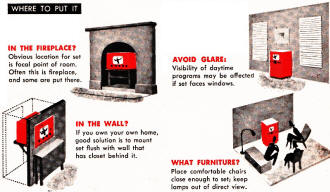
Where to Put It
In the Fireplace? Obvious location for set is focal point of
room. Often this is fireplace, and some are put there. In the Wall? If you own your
own home, good solution is to mount set flush with wall that has closet behind it.
Avoid Glare: Visibility of daytime programs may be affected if set faces windows.
What Furniture? Place comfortable chairs close enough to set; keep lamps out of
direct view.
Buying a TV set? Here are some practical suggestions to help you decide what
you want for how much.
Cover drawing by Reynold Brown
By Carl Dreher
Drawings by Jere Donovan
"How big a set should I buy?"
"How can I tell what's a good buy?"
"Should I install it myself?"
"How about the antenna?"
"Where should I put the set?"
"What about fire and shock hazards?"
"What's the best place to buy a set?"
These are the questions people are asking about television. Last year a novelty,
the galloping postcards now threaten the automobile as the center of family interest.
Grownups stare respectfully at moth-eaten movies that wouldn't pull customers in
a free theater. Children are fascinated into silence. Pronged antennas, the proud
badge of TV ownership, sprout like antlers from all kinds of roofs. So hungry is
the public for this supergadget that sets have been sold where there are no programs
whatever.
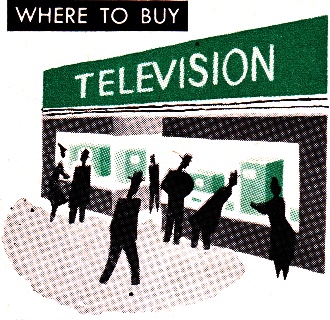
Whether you pick a television shop that's large
or small, in your own locality or another city, make sure it will stand behind its
wares. Don't be afraid to try several places before deciding.
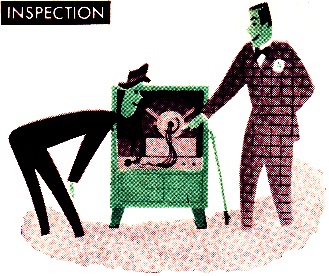
Look closely and ask questions. If the salesman
doesn't know the answers, make him find out - or look for another salesman who does.
See the text of this article for important points to check.
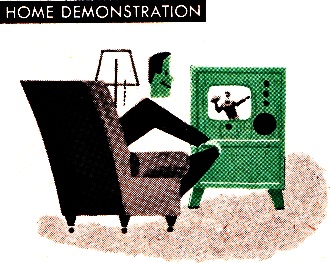
Ask for a home demonstration, particularly if
you buy your set in a store far from your neighborhood, before closing the deal.
Quality of reception is very different in different areas.
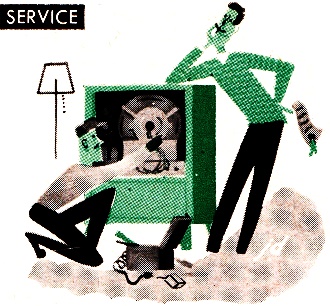
A highly complex electronic gadget, a television
set is not easy to repair. Unless you are an expert and like to tinker with such
things, the seller's one-year guarantee is worth its cost.
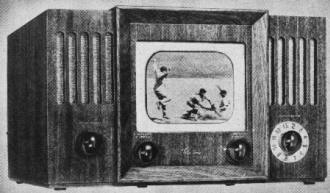
Seven-inch set permits more than one person
to watch show, sells for around $200. Teletone's model (above) operates on either
AC or DC.
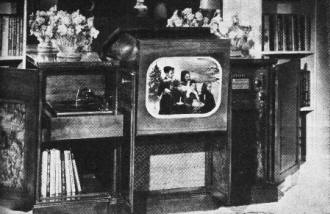
For de luxe entertainment, Du Mont makes the
Westminster™ combination below with 24-inch direct-view screen. It costs about
$2,500.
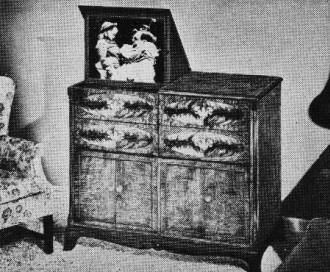
Projection set gives pictures as big as largest
direct-view tubes but not quite so clear. RCA combination model below costs about
$1,500.
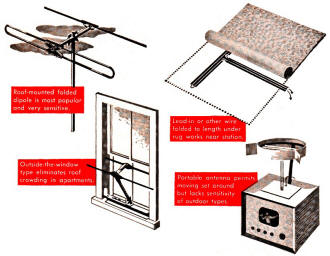
Roof-mounted folded dipole is most popular and very sensitive.
Outside-the-window type eliminates roof crowding in apartments.
Lead-in or other wire folded to length under rug works near station.
Portable antenna permits moving set around but lacks sensitivity
of outdoor types.
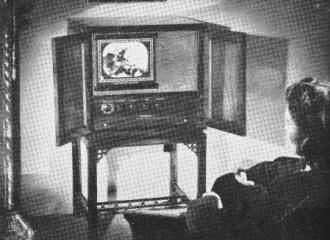
Most popular size is 10-inch, made by most manufacturers
for $325 up, depending partly on cabinet. Westinghouse, below, costs $400.
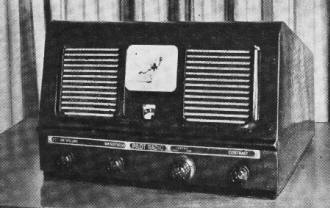
Smallest - and cheapest - television receiver
now on market is this 3-inch Candid™ made by Pilot Radio Corp. It is priced
at about $100.
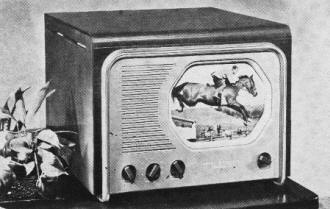
Set has a 12-inch picture tube. GE's new model
814 has 18 tubes and aluminum-backed viewing screen. The price in the East is $389.50.
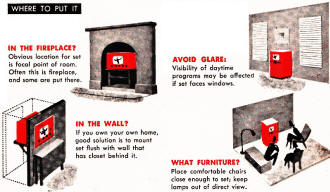
In the Fireplace? Obvious location for set is focal point of
room. Often this is fireplace, and some are put there.
In the Wall? If you own your own home, good solution is to
mount set flush with wall that has closet behind it.
Avoid Glare: Visibility of daytime programs may be affected
if set faces windows.
What Furniture? Place comfortable chairs close enough to set;
keep lamps out of direct view.
Unless you have a sales resistance for radios, cars, and gimmicks unusual among
readers of this magazine, you are probably talking yourself into TV right now. I
won't even discuss what you can see in the little flicker-window. That would be
like asking grandpa with the goggles where he could go in his merry Oldsmobile.
As a new fan for old vaudeville myself, I know you want to talk about the machine,
not the scenery.
Let's suppose you have stopped shuddering at the price tags. You know that TV
is a three-figure dish even at the low end of the menu. You want steak - the question
is, how thick? Or, rather, how wide? Incidentally, a "7-inch tube" refers to the
diagonal of the picture, not the width.
Looking at TV is like reading this page. For one pair of eyes, it's plenty big
enough. But if you want two people to look at the same time, that comes to four-eyes
wide; so you'll have to move back from the screen and make the picture bigger. Two
heads, it seems, are bigger than one.
To decide how big a screen you want, count your money (in $100 bills) on one
hand, and your heads on the other. At present prices, a good rule of thumb is $100
a head. That's the price of a pass to your private theater.
Charted on the opening page are the common screen sizes (tube diameters) and
the number of viewers each can serve well. Calculations are based on six times picture
width, for good viewing, within an angle 25 degrees each side of center. Standees
and floor-squatters would increase the potential audience, but not the comfort.
On this basis, the little 3-inch $100 job, with a screen the size of six postage
stamps, can hardly accommodate a crowd of two people. Even a 7-inch set is on the
intimate side. And nothing less than a 10-inch screen will keep the kids literally
out of your hair.
The 10-inch set is the big seller today because it fits the average family with
one or two children. If you want to run a small television theater for your friends,
get the projection set with a 16-inch picture or, if you can afford it, the more
expensive, equivalent direct-view job, which gives a better image. Actually, either
of these will accommodate, in reasonable optical comfort, more viewers than the
chart shows.
All viewing tubes, whether 3-inch or 20-inch, make their pictures out of 525
individual lines (like the "dots" in the pictures here) and theoretically all might
be capable of equal sharpness. But the bigger sets may produce better images, because
they have improved circuits and more tubes, giving a sharper, clearer, steadier
picture, as well as better reception on weak stations or if you live far from the
transmitter.
Now that you have settled on screen size by counting noses and dollars, consider
set size. Cabinets vary like boxes of soap flakes with the same contents. Your best
bet, if you buy television is to buy television only. Don't go overboard for combination
radio-TV-long & short record-player outfits complete with home-movie screens
and electric organs. If you want these things, get them separately. TV is a swift-changing
piece of equipment: today's biggest screen will seem cramped in a few years. The
less other stuff you have glued onto your present set, the freer you'll feel to
improve it later.
And another point: It is practically certain that television will go up into
the higher frequencies before very long. Some areas will not be affected, in others,
sets will have to be adapted. This may be a factor in how much you want to spend
on one now.
Settled on screen and set size, and there-by price range, you now consider makes.
This is a tough one. A young business, quick with promise of profit like the young
automobile business, TV promotes a lot of nameplates. Many you know as old friends
in radio or appliances. Others are newcomers. But all use the same tubes and many
the same basic components. Again as in automobiles, the reputation and service facilities
of the dealer are important.
With a lot of good money on the line, you have the right to take your time and
ask questions. Look over the floor samples for general workmanship. In demonstrations,
check into these significant points:
Sharpness. Tune in a station that is broadcasting its test pattern - a chart
made up of lines and circles that is put on the air between programs or when there
are no programs. (It is difficult to judge picture quality from a regular program
picture.) Adjust the set for the best image, and then look closely at the black-and-white
lines that converge toward the center. The farther in they show up clearly, the
better.
Contrast. The inner black ring of the test pattern, circling the station call
letters, should be really black, while the successively lighter gray rings should
be obviously different shades of gray.
Drift. Watch the test picture after the set has been on at least 15 minutes,
to see if it holds its sharpness. If the set requires frequent retuning, be suspicious.
Controls. Some receivers have semi-automatic tuning - the picture stays sharp
when the station selector is switched from one station to another. This eliminates
a lot of knob-fiddling but means you'd have to go inside the set to adjust it.
Number of Tubes. In general, the more the better.
Number of Stages of Amplification. Again, the more the better. If the salesman
doesn't know, ask the serviceman.
How to Check Sensitivity
Sensitivity. Find out-from the salesman or instruction book - the sensitivity
of "the set (measured in microvolts per meter) on each channel. It should be at
least as great as the field strength near your home (also measured in microvolts
per meter) of the transmitter using that channel. (Most transmitting stations will
tell you their field strengths in your locality if you write them.) You can make
a visual check on sensitivity by simply tuning in each station.
Audio System. Listen critically to music - live rather than recorded, if possible.
Cabinet. A television set is a piece of furniture, and a prominent one. Make
sure the design will he pleasing in your home.
Home Demonstration. Usually a set will work better away from the interference
caused by traffic, doctors' equipment, and neon signs in the business district.
But sometimes the reverse is true, especially if you live far from the transmitters
or in the "radio shadow" of a hill or building. Ask to see the set operating in
your home. If the dealer refuses - often he will - insist on a money-back guarantee.
If you are not fond of electronic tinkering, buy your set with installation and
a one-year guarantee, which costs 20 per cent of the purchase price. And ask whether
that covers the picture tube for a full-year, or only 90 days. And how about an
option to renew the guarantee at the end of the year?
Where to Put It
Yes, it is possible to install and service a television set yourself. It is even
possible to build a set from available components or complete kits. But just because
you were a hot-shot with a soldering iron in your radio days, don't think TV is
easy meat. Television is a lot more than visible radio. It is more like radar -
which was the maintenance terror of the Army and Navy.
Practically all TV antennas are based on the simple dipole - two arms extending
at right angles to the supporting mast. Together the arms measure half the wave-length
of the band to be received. There are many modifications and extensions of the half-wave
dipole. Some of these are reflecting rods, folding bars that double back on themselves
like trombone slides, and multiple units or arrays to favor particular stations
or portions of the band. Usually separate units are needed to cover the present
low band (channels 2 to 6) and high band (channels 7 to 13).
Signals are piped down from the antenna through twin leads that are matched to
the receiver, or through the more expensive coaxial cables that reduce signal loss.
You may be able to get by with an indoor aerial if you live in an area where
the transmitter lays down a powerful signal. This can be of plastic-insulated twin
lead-in wire or almost any sort of wire. A more elaborate aerial stuck out of the
window is better, though. And a roof aerial picks up still more signal and gives
better protection against "ghosts," or reflections. But then, if you live in an
apartment house, you have the landlord to reckon with.
Among the accessories that you may wish to consider are enlarging lenses, filters,
and boosters.
Lenses will give you a larger picture, but you'll have to sit almost directly
in front of them. Before buying one, make sure it won't interfere with the tuning
knobs. Lenses may give an impression of a rounded screen; if you don't mind this,
or appearances, a lens may be a good investment, especially for a 7-inch set. Some
sets with built-in lenses to produce 60-square-inch pictures from 7-inch tubes may
be good buys. But the picture produced is not the equivalent of an unmagnified picture
from a 12-inch tube.
Filters that fit over the screen may improve the picture under some conditions.
They provide color discrimination and improve contrast - with some loss in light.
This usually can be made up by increasing the picture brightness. Filters also improve
the picture's visibility, because room light has to pass through the filter twice,
while the tube's light passes through only once.
A booster - an extra, separate stage of radio-frequency amplification - may help,
particularly with a small set far from the transmitter. To find out, try one.
Before you buy your set, decide where you are going to put it. You may be able
to mount the set in a wall or bookcase that has a closet on the other side.
Perhaps the ideal place for TV viewing is the dining room. This keeps the living
room for living - reading, writing, cards, and talk can't stand the competition
when the set is running. With TV in the dining room, you simply turn the chairs
to face the set.
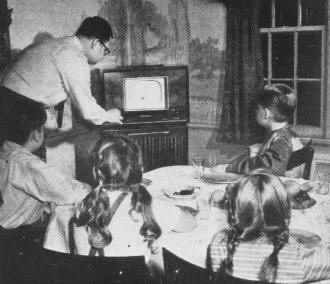
The dining room makes a good video theater, since it has easy-to-move
chairs and a big table for refreshments and ash trays.
TV sets have some special hazards - although the Underwriters Laboratories are
not too worried. With 20 tubes going, the sets put out more heat than a radio. Blocking
ventilation holes behind and under the set may result in a fire. If you ever smell
insulation cooking, turn off the set, pull the plug, smother the set with a rug
or use a nonaqueous extinguisher.
There is no serious shock hazard with small sets; large ones should - and most
do - have an automatic switch to cut off the power when the cabinet lid is lifted.
But you can get quite a jolt from the picture-tube terminals, even after the set
has been disconnected. If you remove the cathode-ray tube from the set, handle with
care - it can explode like a big incandescent lamp. There is no danger when it is
inside the cabinet, since the screen is covered with a plate of safety glass.
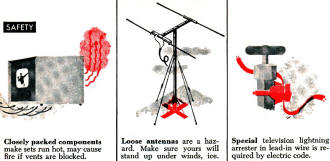
Closely packed components make sets run hot, may cause fire
if vents are blocked.
Loose antennas are a hazard. Make sure yours will stand up under
winds, ice.
Special television lightning arrester in lead-in wire is required
by electric code.
The roof antenna is a greater potential danger than the set itself. It should
be securely mounted so that winds, snow, or ice cannot break it loose to fall on
passers-by.
Where to buy depends on where you live. Generally, the biggest dealer nearest
you is safest - TV isn't a car you can roll into any service station. If you are
investing in a big-screen, big-money set you will gravitate to the plush salon with
the most models. This may also be a good place to buy a small set. But a neighborhood
dealer is handier when you have trouble after hours. He may even listen more attentively
to money talking - something knocked off the list price is not unknown even today.
For accessories, kits, or assembled sets that you expect to service yourself,
mail-order buying is optional. Big mail-order houses have been satisfying radio
customers for decades, and they can be expected to do the same for television purchasers.
Posted February 8, 2024
Color and Monochrome (B&W) Television
Articles
|
























